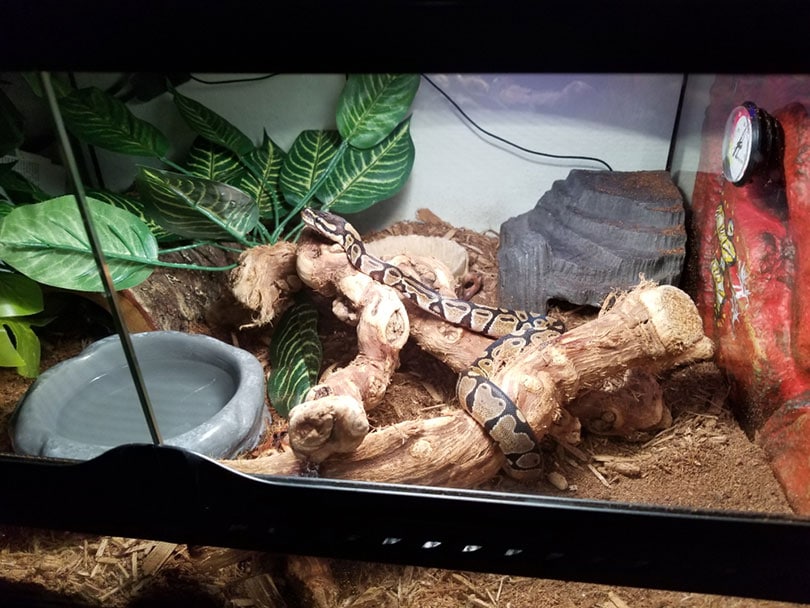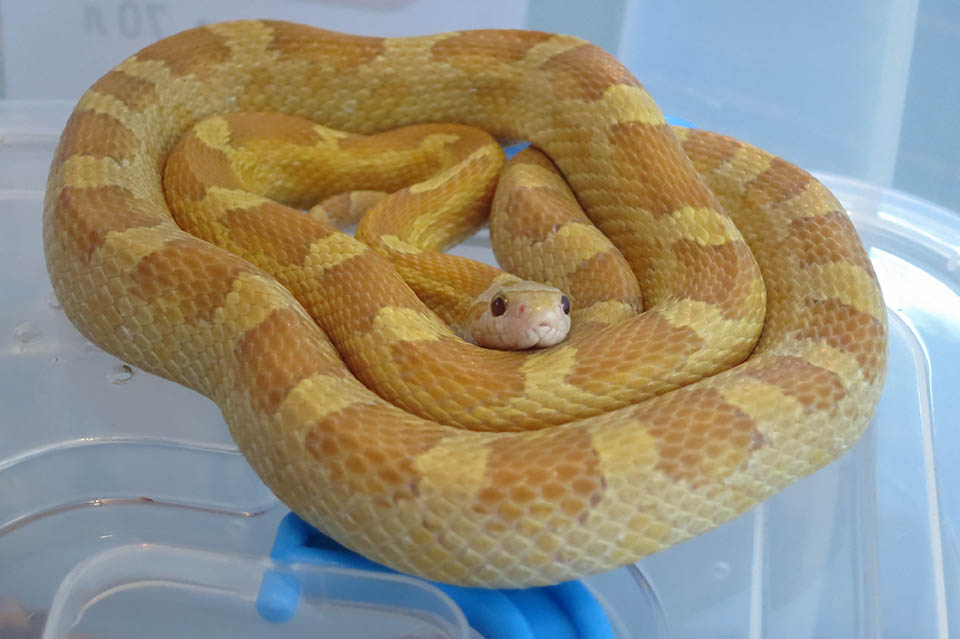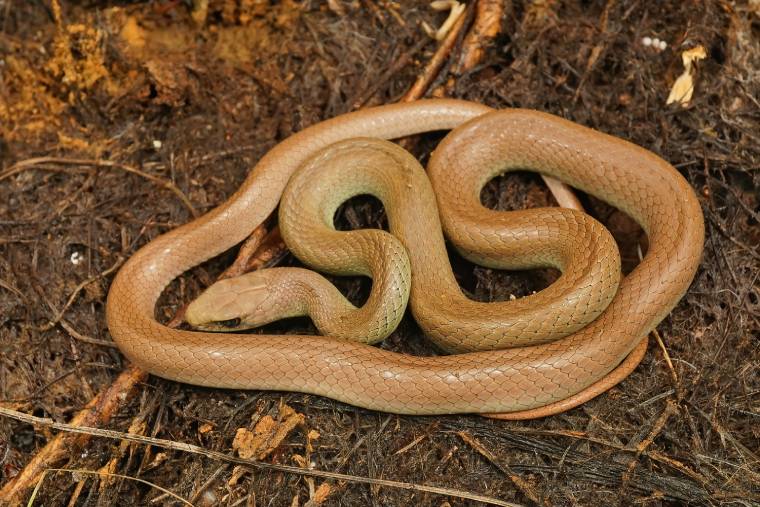
Ball pythons, also referred to as royal pythons, are a species of python that is native to West and Central Africa. They are one of the most popular species of snake kept as pets due to their docile nature, ease of handleability, and lower maintenance husbandry requirements.
The albino ball python is a naturally occurring genetic mutation that results in visual changes in the snake’s coloration. Albinism is found throughout the animal kingdom and this mutation in the ball python yields a snake with a white body, yellow to orange patterning, with pinkish-red eyes.
Quick Facts About Albino Ball Pythons
| Species Name: | Python regius |
| Family: | Pythonidae |
| Care Level: | Beginner |
| Temperature: | 85°-91°F (hot side) 78°-80°F (cool side) |
| Temperament: | Docile |
| Color Form: | Albino (yellow-orange and white with red eyes) |
| Lifespan: | 20-40 years |
| Size: | 3-6 feet |
| Diet: | Rats, mice |
| Minimum Tank Size: | 15-20 gallons (baby); 40 gallons (adult) |
| Tank Set-Up: | Hot side, cool side, hide on each side of the terrarium, water dish, enrichment décor |
Albino Ball Python Overview
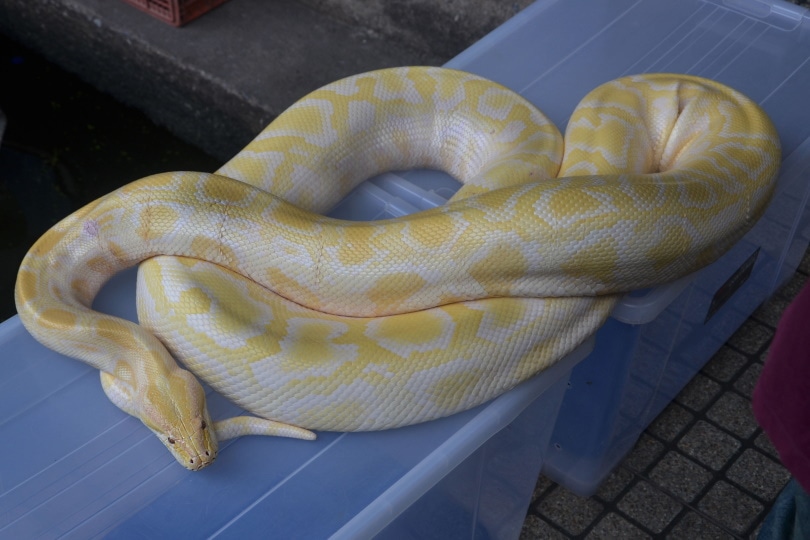
The albino ball python is a naturally occurring morph of ball python that is native to Africa. Ball pythons are one of the forty-two species that make up the python family and the smallest of the African pythons. Most ball python morphs that are commercially available in the pet trade are the result of captive breeding; however, albinos are also found in the wild.
Ball pythons get their name from their natural defensive posture where they curl into a ball to protect their heads. The history of ball pythons in the pet trade is not widely documented but their popularity began to soar around the 1980s due to their docile temperaments, manageable size, low-maintenance care requirements, and color morph varieties. To this day, ball pythons remain the most popular species of pet snake among beginner hobbyists and herpetologists.
These beautiful constrictors have an average lifespan of 20 to 40 years and reach approximately 3 to 6 feet in length. They are an overall healthy and hardy species as long as they are properly cared for and their husbandry requirements are met.
Though albino ball pythons have been found in their native regions of Africa, the first captive-bred specimens were produced in 1992 by the famous reptile breeder, Bob Clark. This recessive gene has been a staple in selective breeding programs and has resulted in the production of many more ball python morph varieties.
How Much Do Albino Ball Pythons Cost?
The cost of an albino ball python ranges from $300 to $500. Since they were one of the first recessive ball python morphs in the pet trade, they have become more widely available over time and are now one of the most affordable morph varieties for reptile keepers. This is a drastic price decrease from 1992 when the first albinos were sold for over $7,500 each.
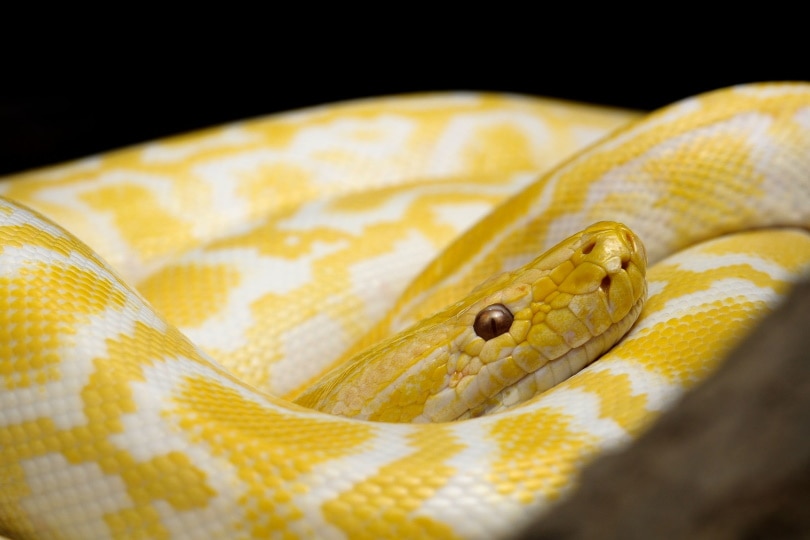
Typical Behavior & Temperament
Ball pythons typically have a very docile temperament and are a more reclusive species of snake. They will spend most of their time in the comfort of their hides. Babies tend to be much more shy and wary of humans but have the potential to become more comfortable with human contact over time with proper handling.
Keepers will want to handle their ball python regularly, approximately once per week for no more than 10 minutes per handling session. Excessive handling can cause the snake unnecessary stress and lead to more defensive behavior. Overall, ball pythons are one of the easiest snakes to handle, which is why they make such popular pets.
Appearance & Varieties
All ball pythons have small heads with two nostrils and distinct heat-receptive pits that are located below the nostrils and above the mouth. They have relatively thin necks with thick, stocky bodies. As adults they can reach anywhere between 3 and 6 feet, however, they rarely reach the 6-foot mark and typically max out between 4 and 5 feet. Males are generally smaller and less heavily bodied than females.
Your typical albino ball python will have a white body, yellow to orange patterning, and eyes that range from pink to red. Albino ball pythons have been incorporated into a wide variety of other morphs.
The standard albino comes in two varieties, high contrast, and low contrast. It is difficult to tell the difference between the two as hatchlings, but low contrast albinos will slowly lose their white markings as they age and will become almost completely yellow all over. High contrast albinos will retain their yellow to white contrast and typically cost more than the low contrast variety. These different contrasts are selectively bred.
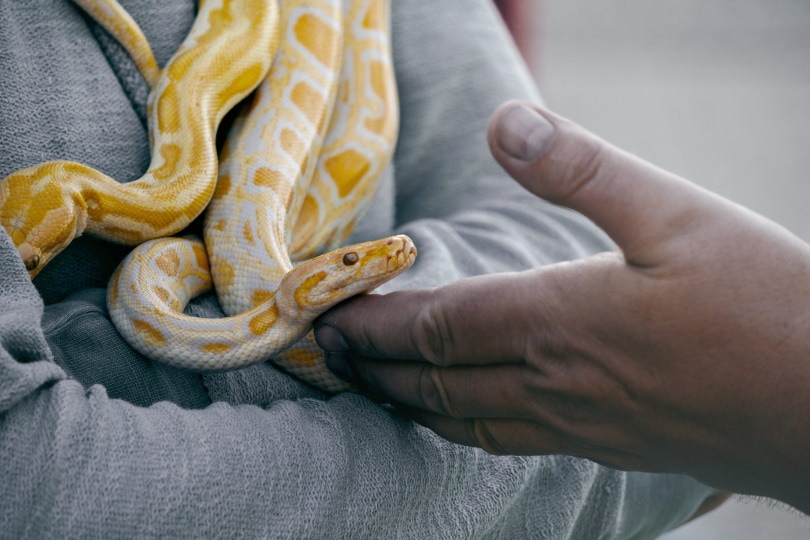
How to Take Care of an Albino Ball Python
Habitat, Tank Conditions & Setup
Tank
If you choose to purchase an albino ball python as a baby, it is highly recommended to keep it in a smaller enclosure between 15 and 20 gallons. Some of the most experienced reptile keepers advise that this will make them feel more safe and secure in their habitat. As your snake grows, you can increase the size of the enclosure. Adults typically require an enclosure between 40 and 50 gallons.
Many snake keepers utilize PVC enclosures that are not measured in gallons. Depending on the size of your adult ball python, you can expect to need an enclosure that measures between 36 and 60 inches in length, at least 12 inches in height, and 14 inches in width.
You should have at least two hides available in the enclosure that are appropriate to the snake’s age and size, one located on the cool side, and one located on the warm side. A water dish should also be provided that is large enough for the snake to soak in. Clean, fresh water should always be available
Heating (Temperature & Humidity)
Ball pythons are cold-blooded and cannot regulate their body temperature. Maintaining correct temperature and humidity levels is extremely important for the overall health of your ball python
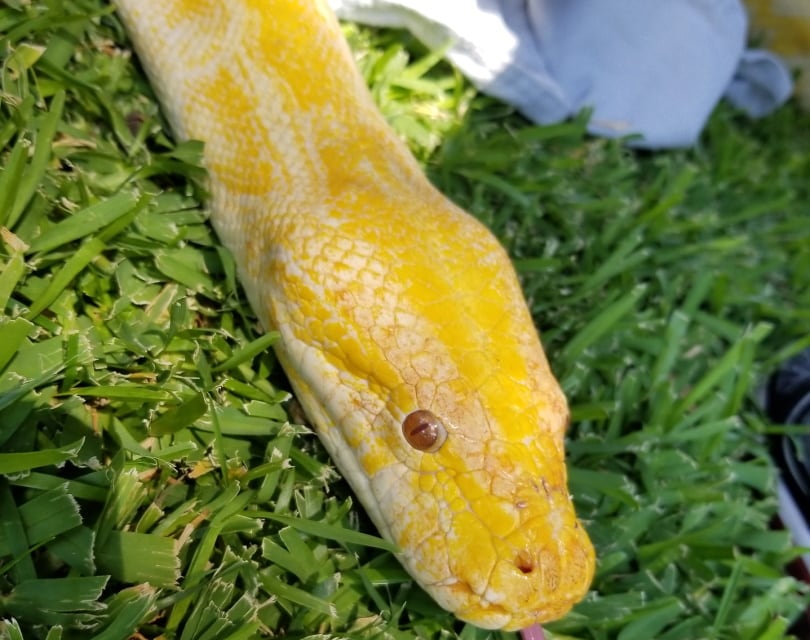
Temperature
Contrary to popular belief, ball pythons do not require any special lighting such as UVB like some other reptiles. UVB lighting can be especially harmful to albino ball pythons due to the lack of melanin and increased sensitivity related to albinism. It’s best to have your natural room lighting mimic normal day and night cycles.
You need to have a dedicated hot and cool side in your snake’s enclosure with a hide available on each side. Heating tape, a heating mat, or a radiant heat panel are some of the best methods of heating a ball python’s enclosure.
The hot side should be kept between 85°-91°F and should never exceed 93°F. The cool side should be kept at approximately 80°F and never below 75°F. The average ambient, or overall temperature of the enclosure should remain near 82°F. These temperatures can easily be controlled by having a thermostat and can be monitored by
Humidity
On average, ball pythons need to have about 60% humidity in their enclosure. Baby ball pythons may sometimes need the humidity to be slightly higher. To maintain humidity levels, you can mist the enclosure with fresh, clean water, only slightly dampening the substrate. You can place the water dish on the hot side of the enclosure which will cause the water to evaporate more quickly and release humidity.
Humidity is very important for proper shedding, if your ball python is having trouble shedding, you can add sphagnum moss to a hide and slightly dampen it. You can monitor humidity levels in the enclosure by purchasing a hygrometer.
Substrate
There are a few different types of substrates you can use in your albino ball python enclosure. Some keepers choose to use newspaper or paper towels. If you want to utilize a more naturalistic substrate you can use coconut fiber, aspen chips, cypress mulch, or fir bark.
You should never use sand or cedar substrate for ball pythons. Sand can be very harmful, as it can be ingested during feeding and cause serious impaction of the digestive system that can ultimately lead to death. Cedar is highly toxic to snakes and other reptiles due to the oils and fumes
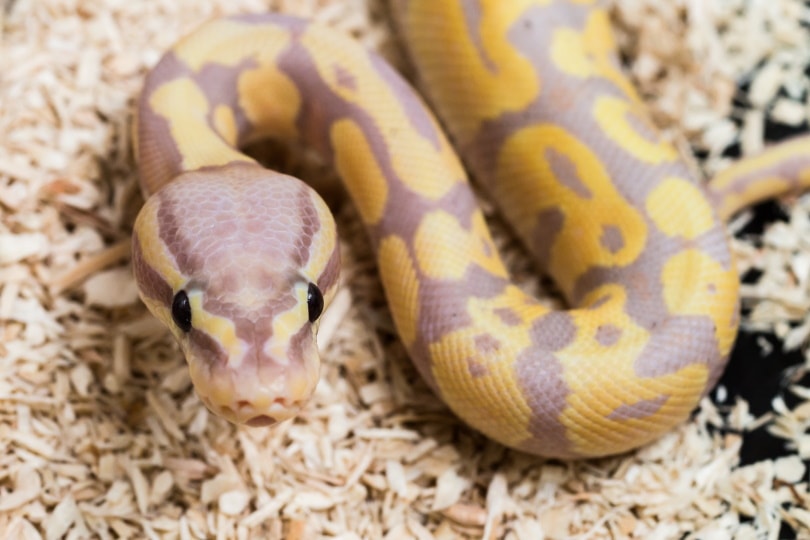
Do Albino Ball Pythons Get Along with Other Pets?
Albino ball pythons should never cohabit with other snakes of the same or any other species due to the risk of cannibalism. Ball pythons should be housed alone and should never have access to any other household pets for the safety of all animals.
If the animal is prey-sized, you would run the risk of your snake consuming them. If the animal is larger than your snake, you would run the risk of your snake being seriously injured or killed.
Feeding Your Albino Ball Python
Ball pythons should be fed a diet consisting primarily of rodents, ideally captive-bred, appropriately sized rats, or mice. Ball pythons can be finicky eaters that tend to imprint on a particular food source. Since rats will be more appropriately sized as they age, it is recommended to offer rats as the primary food source as soon as possible.
It is very important to feed your snake appropriately sized prey that is no wider than the widest part of the snake’s body. This will prevent any issues with digestion and help prevent the regurgitation of oversized prey.
Offering frozen-thawed rodents is widely recommended not just for ethical reasons but for the safety of your snake. Live prey can be potentially harmful to your snake, as they can bite, scratch, and defend themselves. This can lead to wounds, potential infection, and unnecessary veterinary bills.
Some keepers do have trouble with ball pythons accepting frozen-thawed prey. You can attempt to space out feeding by an additional week to help entice your snake to take the frozen-thawed prey. If you must offer live prey, never leave your snake unattended with them and remove the prey immediately if your snake does not show interest in eating.
An appropriate feeding schedule for juvenile snakes is typically once every week to two weeks, while adult snakes can be fed once every two to four weeks. For the best recommendations for feeding, contact your licensed exotic animal veterinarian.
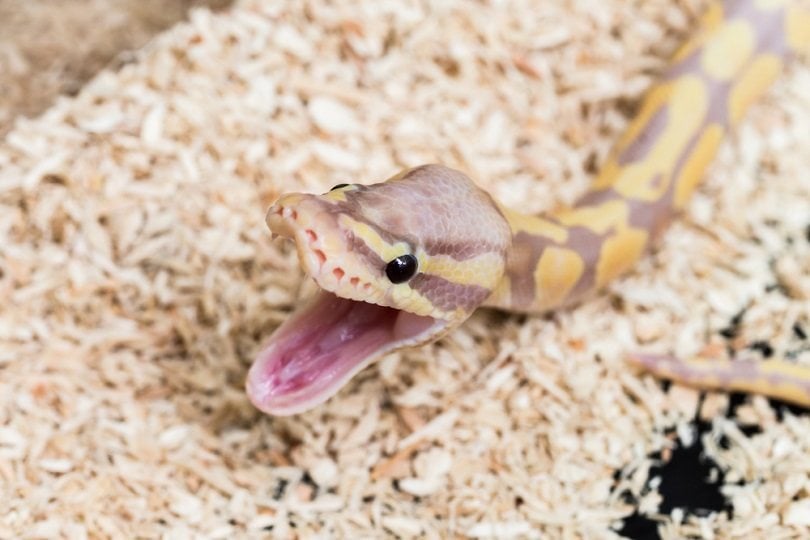
| Diet Summary | |
| Fruits | 0% of diet |
| Insects | 0% of diet |
| Meat | 100% of diet – small/medium-sized rats or mice |
| Supplements Required | N/A
|
Keeping Your Albino Ball Python Healthy
Proper care and husbandry are essential in maintaining your snake’s overall health and longevity. While ball pythons are typically a hardy species, there are some health concerns to be aware of. You need to ensure you have a licensed veterinarian that has experience with snakes and reptiles in case your snake needs medical attention.
Mites
Mites are a type of parasite that infest snakes, they often hide in the grooves between the scales on the underside of the jaws. These mites reproduce very quickly and will need to be dealt with promptly. You may notice your ball python soaking in the water dish to get the mites off. Severe infestations can lead to anemia and even death.
You will need to ensure you not only treat your ball python but the entire enclosure. There are many treatment options available, it is always recommended to reach out to your veterinarian for the best guidance.
Respiratory Infection
Respiratory infections and pneumonia are typically caused by poor husbandry practices. The most common cause of respiratory infections in ball pythons is an environment that is too cold or the humidity is too high. The telltale sign of respiratory infections in snakes is a distinct wheeze. Some other, more severe signs of respiratory infection are holding the head up, open mouth breaking, gurgling noises while breathing and mucous discharge. A ball python with a respiratory infection will need to see a veterinarian right away.

Issues with Shedding
Issues with shedding, also referred to as dysecdysis, are a common problem observed in snakes. Snakes shed as they grow and will continue to shed throughout their lives. Shedding issues are typically a result of poor humidity or lack of objects in the enclosure to assist in the shedding process.
Snakes shed their entire body including their eye caps (called spectacles). If the caps don’t come off, it could lead to them being aggressive or skipping meals since their vision will be decreased. If the caps don’t come off after the next shed, you should seek veterinary care.
Scale Rot
Scale rot is a blanket term for issues related to the snake’s scales or skin. It can be used to describe dermatitis, burns, bacterial abscesses, and even secondary bacterial infections that result from abrasions or burns. Scale rot can be prevented by proper husbandry and prompt treatment of any injury.
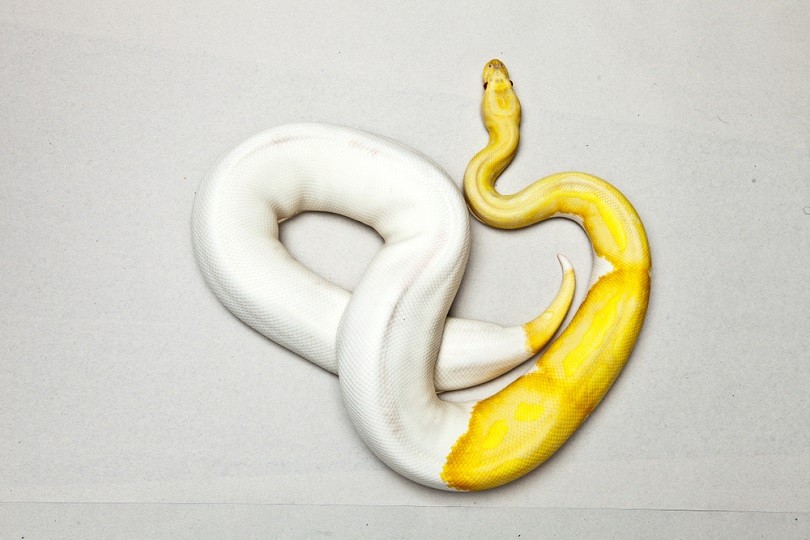
Breeding
Many keepers breed ball pythons to either add to their collection, turn it into a hobby or even begin a small business. Breeding your albino ball python or any other variety will require knowledge of genetics, as serious genetic health conditions such as neurological disorders can occur.
If you want to breed your ball python you will need to ensure the snake is of ideal breeding age and size, have knowledge on proper breeding conditions, how to properly pair males and females, recognize ovulation, then successfully incubate and hatch the eggs.
Shedding and Brumation: What to Expect
Shedding
An albino ball python will shed multiple times throughout their life. The frequency of shedding will decrease as your snake ages, but shedding will continue throughout its lifespan. Younger snakes shed more often, as they are growing at a faster rate.
When your ball python is getting ready to shed, the scales will take on a duller appearance, the eyes will begin to appear cloudy and blue, and their underside will appear pinkish. It is completely normal for your albino ball python to refuse meals while they shed.
Proper humidity levels are very important for a healthy, full shed. You can even raise the humidity level in the enclosure slightly to help ensure a complete shed. It’s also recommended to have objects in the enclosure available for your snake to rub against to assist in the process.

Brumation
Ball pythons do not go through a period of brumation; however, some adult ball pythons may eat much less, or refuse to eat at all during the colder, winter months. Generally, those going on an eating strike will return to normal feeding habits in late winter or early spring. Any concerns with the frequency of feeding should be discussed directly with a veterinarian.
Are Albino Ball Pythons Suitable for You?
If you are looking for a snuggly pet that showers you in love and attention, an albino ball python or any other snake is not going to be the right pet for you. Snakes are instinctual animals that do not have the same emotional capacity as mammals such as dogs and cats.
You will also want to consider the snake’s feeding requirements, feeding a whole prey item may be emotionally difficult for some individuals. If you feel you would have trouble doing so, you may want to consider other pets.
Albino ball pythons are great pets for those with busy lifestyles, as they do not require social interaction like most other household pets and they only eat once every 2-4 weeks as adults.
Conclusion
Albino ball pythons are not only beautiful, but they also make a great choice for reptile keepers of all experience levels. They are wonderful for beginners due to their docile nature and relatively low-maintenance care requirements.
Featured Image Credit: Tatem Marie Miley, Shutterstock

